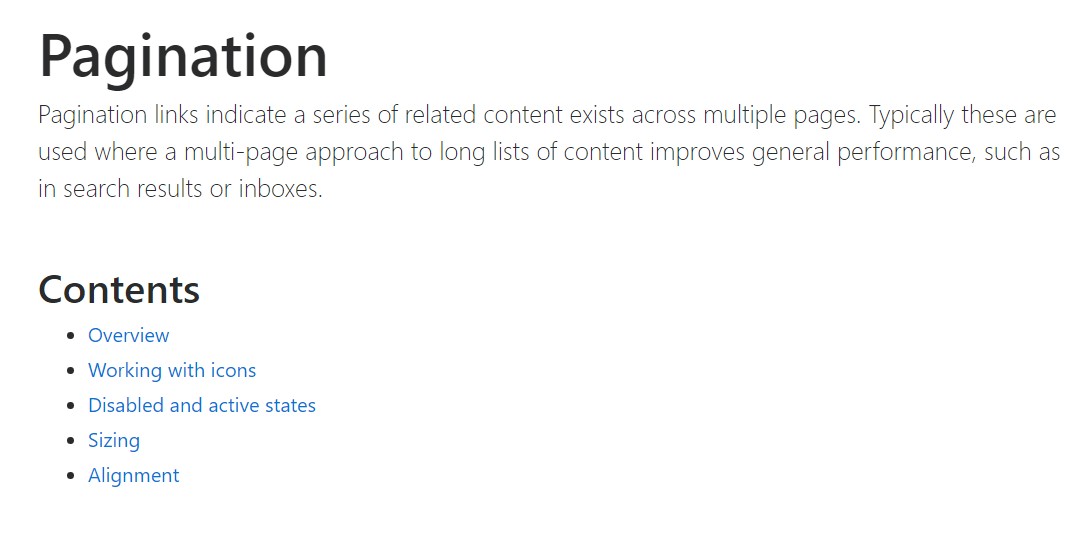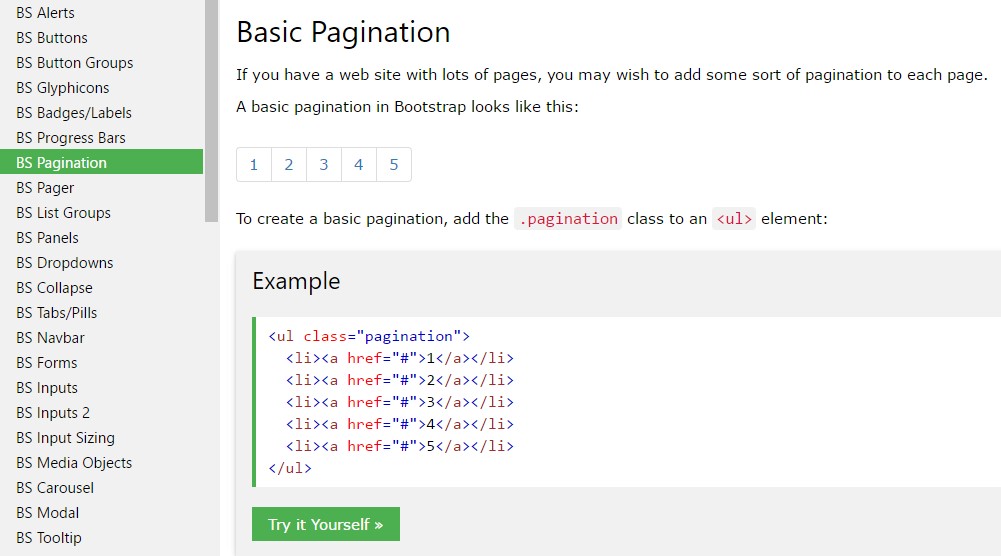Bootstrap Pagination Responsive
Overview
An upward trend in the front-end world is the use of CSS frameworks with base styles for our page. Instead of starting every project from scratch, creating every style in the hand, there are frameworks that already bring a whole built base from where we will start our application.
Bootstrap gives a lot of functions:
● Totally reset CSS
● Base visual look for a large number of tags
● Icons.
● Grids ready for usage.
● CSS Components.
● JavaScript Plugins.
● All responsive and mobile-first .
As its name implies, it is a method to launch the project shortly with a practical concept and elements without wasting design time in the beginning.
Necessary pagination conceptions.
Whenever we have a webpage along with many different items to show, paging comes to be required. We know that in the case of lists, such as presenting products in internet shops as well as search results in systems, the need is not to show each of the items simultaneously, but alternatively to organise them effectively, making them much simpler to access, faster and more typical pages.
Listed below are some great strategies in the use of Bootstrap Pagination, regardless of the technology used ( read this)
Pagination: an additional title.
When successfully built, paging dispenses the title. That is , if you needed to write "Pagination" for the user of Bootstrap Pagination Example to make use of, there is some thing inappropriate: consider redesigning it!
Effective visibility and position.
Paging is a completing site navigation and really should offer effective placement and great visibility. Apply fonts with proportions and colors that follow the design of page usage, delivering good exposure and locating it properly after the item list ends.
Be practical.
Some paging tools provide enhanced navigating functions like going straightaway to a certain page or perhaps advancing a specific amount of webpages at one time. Despite the fact they are extra components, users are much more accustomed to easy designs and do much better by using usual models.
Deliver ordering possibilities.
A great and strongly recommended capability is to bring ordering methods to enhance their usage.
Do not make use of subscript designs on web links.
In paging devices, these capabilities are needless, since the hyperlinks are clear and the subscript look will just keep the visional filled. ( learn more)
Grant proper place for clickable areas.
The bigger the clickable space the much more easily accessible the tabs become and because of this much easier to work with.
Provide zones in between hyperlinks
Gap coming from one button to another will build paging a lot more user-friendly and comfortable , avoiding unwanted connection.
Establish the present web page and provide the general navigating hyperlinks.
The paging job is to facilitate user navigation, so the tool should really keeping it very clear exactly where the user is, exactly where he has been and where he has the ability to proceed.
Generate standard site navigation urls just like "Previous Page" together with "Next Page", always locating them at the starting point and end.
Bring helpful shortcuts and additional help and advice
Links to the "first page" and "last page" are usually valuable, look at them in the event that it is necessary!
Employ a wrapping
<nav>Additionally, as webpages possibly have more than just one such site navigation area, it's advisable to deliver a detailed
aria-labelaria-label="Search results pages".<nav aria-label="Page navigation example">
<ul class="pagination">
<li class="page-item"><a class="page-link" href="#">Previous</a></li>
<li class="page-item"><a class="page-link" href="#">1</a></li>
<li class="page-item"><a class="page-link" href="#">2</a></li>
<li class="page-item"><a class="page-link" href="#">3</a></li>
<li class="page-item"><a class="page-link" href="#">Next</a></li>
</ul>
</nav>Bootstrap Pagination
Basic Bootstrap Pagination Demo
If you have a web site using plenty of pages, you may perhaps like to put in some form of pagination to every webpage.
To produce a standard pagination, incorporate the
.pagination<ul>
<nav>
<ul class="pagination">
<li class="page-item">
<a href="#" class="page-link" aria-label="Previous">
<span aria-hidden="true">«</span>
</a>
</li>
<li class="page-item"><a href="#" class="page-link">1</a></li>
<li class="page-item"><a href="#" class="page-link">2</a></li>
<li class="page-item"><a href="#" class="page-link">3</a></li>
<li class="page-item"><a href="#" class="page-link">4</a></li>
<li class="page-item"><a href="#" class="page-link">5</a></li>
<li class="page-item"><a href="#" class="page-link">6</a></li>
<li class="page-item"><a href="#" class="page-link">7</a></li>
<li class="page-item">
<a href="#" class="page-link" aria-label="Next">
<span aria-hidden="true">»</span>
</a>
</li>
</ul>
</nav>Bootstrap 4 and Bootstrap 3 contrasts
Bootstrap 3 only involves the
.paginationBootstrap 4, as well as the
.pagination.page-item<li>.page-link<a>Using icons
Seeking to employ an icon or symbol instead of text message for some pagination hyperlinks? Ensure to produce proper screen reader support with
aria.sr-only<nav aria-label="Page navigation example">
<ul class="pagination">
<li class="page-item">
<a class="page-link" href="#" aria-label="Previous">
<span aria-hidden="true">«</span>
<span class="sr-only">Previous</span>
</a>
</li>
<li class="page-item"><a class="page-link" href="#">1</a></li>
<li class="page-item"><a class="page-link" href="#">2</a></li>
<li class="page-item"><a class="page-link" href="#">3</a></li>
<li class="page-item">
<a class="page-link" href="#" aria-label="Next">
<span aria-hidden="true">»</span>
<span class="sr-only">Next</span>
</a>
</li>
</ul>
</nav>Active capacity
The active state shows what exactly the existing webpage is.
Add
.active
<nav>
<ul class="pagination">
<li class="page-item">
<a href="#" class="page-link" aria-label="Previous">
<span aria-hidden="true">«</span>
</a>
</li>
<li class="page-item"><a href="#" class="page-link">1</a></li>
<li class="page-item"><a href="#" class="page-link">2</a></li>
<li class="page-item"><a href="#" class="page-link">3</a></li>
<li class="page-item active"><a href="#" class="page-link">4</a></li>
<li class="page-item"><a href="#" class="page-link">5</a></li>
<li class="page-item"><a href="#" class="page-link">6</a></li>
<li class="page-item"><a href="#" class="page-link">7</a></li>
<li class="page-item">
<a href="#" class="page-link" aria-label="Next">
<span aria-hidden="true">»</span>
</a>
</li>
</ul>
</nav>Disabled Condition
A disabled link can not be clicked on:
If a url for some reason is disabled, add
.disabled
<nav>
<ul class="pagination">
<li class="page-item">
<a href="#" class="page-link" aria-label="Previous">
<span aria-hidden="true">«</span>
</a>
</li>
<li class="page-item"><a href="#" class="page-link">1</a></li>
<li class="page-item"><a href="#" class="page-link">2</a></li>
<li class="page-item"><a href="#" class="page-link">3</a></li>
<li class="page-item disabled"><a href="#" class="page-link">4</a></li>
<li class="page-item"><a href="#" class="page-link">5</a></li>
<li class="page-item"><a href="#" class="page-link">6</a></li>
<li class="page-item"><a href="#" class="page-link">7</a></li>
<li class="page-item">
<a href="#" class="page-link" aria-label="Next">
<span aria-hidden="true">»</span>
</a>
</li>
</ul>
</nav>Pagination Sizing
Paging blocks can as well be sized to a bigger or smaller size.
Add
.pagination-lg.pagination-sm
<nav>
<ul class="pagination pagination-lg">
<li class="page-item">
<a href="#" class="page-link" aria-label="Previous">
<span aria-hidden="true">«</span>
</a>
</li>
<li class="page-item"><a href="#" class="page-link">1</a></li>
<li class="page-item"><a href="#" class="page-link">2</a></li>
<li class="page-item"><a href="#" class="page-link">3</a></li>
<li class="page-item"><a href="#" class="page-link">4</a></li>
<li class="page-item"><a href="#" class="page-link">5</a></li>
<li class="page-item"><a href="#" class="page-link">6</a></li>
<li class="page-item"><a href="#" class="page-link">7</a></li>
<li class="page-item">
<a href="#" class="page-link" aria-label="Next">
<span aria-hidden="true">»</span>
</a>
</li>
</ul>
</nav>
<nav>
<ul class="pagination">
<li class="page-item">
<a href="#" class="page-link" aria-label="Previous">
<span aria-hidden="true">«</span>
</a>
</li>
<li class="page-item"><a href="#" class="page-link">1</a></li>
<li class="page-item"><a href="#" class="page-link">2</a></li>
<li class="page-item"><a href="#" class="page-link">3</a></li>
<li class="page-item"><a href="#" class="page-link">4</a></li>
<li class="page-item"><a href="#" class="page-link">5</a></li>
<li class="page-item"><a href="#" class="page-link">6</a></li>
<li class="page-item"><a href="#" class="page-link">7</a></li>
<li class="page-item">
<a href="#" class="page-link" aria-label="Next">
<span aria-hidden="true">»</span>
</a>
</li>
</ul>
</nav>
<nav>
<ul class="pagination pagination-sm">
<li class="page-item">
<a href="#" class="page-link" aria-label="Previous">
<span aria-hidden="true">«</span>
</a>
</li>
<li class="page-item"><a href="#" class="page-link">1</a></li>
<li class="page-item"><a href="#" class="page-link">2</a></li>
<li class="page-item"><a href="#" class="page-link">3</a></li>
<li class="page-item"><a href="#" class="page-link">4</a></li>
<li class="page-item"><a href="#" class="page-link">5</a></li>
<li class="page-item"><a href="#" class="page-link">6</a></li>
<li class="page-item"><a href="#" class="page-link">7</a></li>
<li class="page-item">
<a href="#" class="page-link" aria-label="Next">
<span aria-hidden="true">»</span>
</a>
</li>
</ul>
</nav>Change the positioning of pagination parts with flexbox utilities.

<nav aria-label="Page navigation example">
<ul class="pagination justify-content-center">
<li class="page-item disabled">
<a class="page-link" href="#" tabindex="-1">Previous</a>
</li>
<li class="page-item"><a class="page-link" href="#">1</a></li>
<li class="page-item"><a class="page-link" href="#">2</a></li>
<li class="page-item"><a class="page-link" href="#">3</a></li>
<li class="page-item">
<a class="page-link" href="#">Next</a>
</li>
</ul>
</nav>
<nav aria-label="Page navigation example">
<ul class="pagination justify-content-end">
<li class="page-item disabled">
<a class="page-link" href="#" tabindex="-1">Previous</a>
</li>
<li class="page-item"><a class="page-link" href="#">1</a></li>
<li class="page-item"><a class="page-link" href="#">2</a></li>
<li class="page-item"><a class="page-link" href="#">3</a></li>
<li class="page-item">
<a class="page-link" href="#">Next</a>
</li>
</ul>
</nav>Examine a couple of video clip guide regarding Bootstrap Pagination
Connected topics:
Bootstrap pagination official information

W3schools:Bootstrap pagination tutorial

Centering the pagination in Bootstrap

